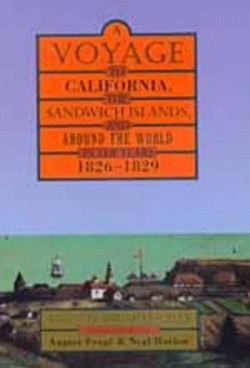A Voyage to California, the Sandwich Islands, and Around the World in theYears 1826-1829
Historians and general readers will welcome Frugé and Harlow’s well-illustrated, fully annotated translation of Duhaut-Cilly’s journals of his 1826-1829 trading voyage. The French captain’s two years in Alta and Baja California are central; coastal trips to Mexico and Peru are briefly described, but much of the very interesting Sandwich Islands (Hawaii) and Canton sojourns on the ongoing voyage are retained. This editing is purposeful: the historian-translators have stripped the original, somewhat archaic, 800-page text of much specialized maritime and commercial detail to highlight Duhaut-Cilly’s rich, engaging account of California and Hawaii in the process of dramatic change.
Over the course of almost two years, Duhaut-Cilly sailed the California coast from San Diego to San Francisco. In furtherance of trade or curiosity, he made numerous inland journeys to the Franciscan-run missions (in many ways the region’s spine), the presidios and the slowly growing pueblos or townships. Humanist, progressive economist (agricultural and commercial), trained observer and literary stylist, Duhaut-Cilly provides a finely detailed, long last survey of the old, mission-dominated California. What a world it was and how suddenly the old order passed. In 1821 Mexican rule had replaced Spanish rule; in 1828 Duhaut-Cilly witnessed the reading of the decree expelling Spaniards from California, and by 1832 the Franciscans were leaving, knowing that their own expulsion and secularization of the missions was imminent.
Duhaut-Cilly’s great strength is human-interest narrative. He describes the serf-Indians toiling on the magnificent mission spreads, their own agriculture and villages failing; he notes the seemingly carefree Spanish family farms where there was title to nothing and all futures were at risk. He contrasts Russian drive and efficiency in their San Francisco area base with the dirty casualness of Mexican presidios. His descriptions of untroubled daily life hint at familiarity with Bernardin de Saint-Pierre and Chateaubriand, but with the added merit of perceptive anthropological notes; his thoughts on liberty call up the Enlightenment philosophers. The Hawaiian chapters nicely detail the dynamics of missionary-fueled subversion of the indigenous culture and social order, and the Canton notes are colorful and usefully advise against attempted erotic encounters.
At no time did Duhaut-Cilly forget that he was on a semi-official trade mission for France, with the responsibility to map routes and assess market potential—or that his account should include vivid descriptions of shipboard life, roguery and discipline. He did well by this duty.
Illustrations, maps, charts, a selected bibliography and a comprehensive introduction adds to this unmatched portrait of California in the 1820s.
Reviewed by
Peter Skinner
Disclosure: This article is not an endorsement, but a review. The publisher of this book provided free copies of the book to have their book reviewed by a professional reviewer. No fee was paid by the publisher for this review. Foreword Reviews only recommends books that we love. Foreword Magazine, Inc. is disclosing this in accordance with the Federal Trade Commission’s 16 CFR, Part 255.

